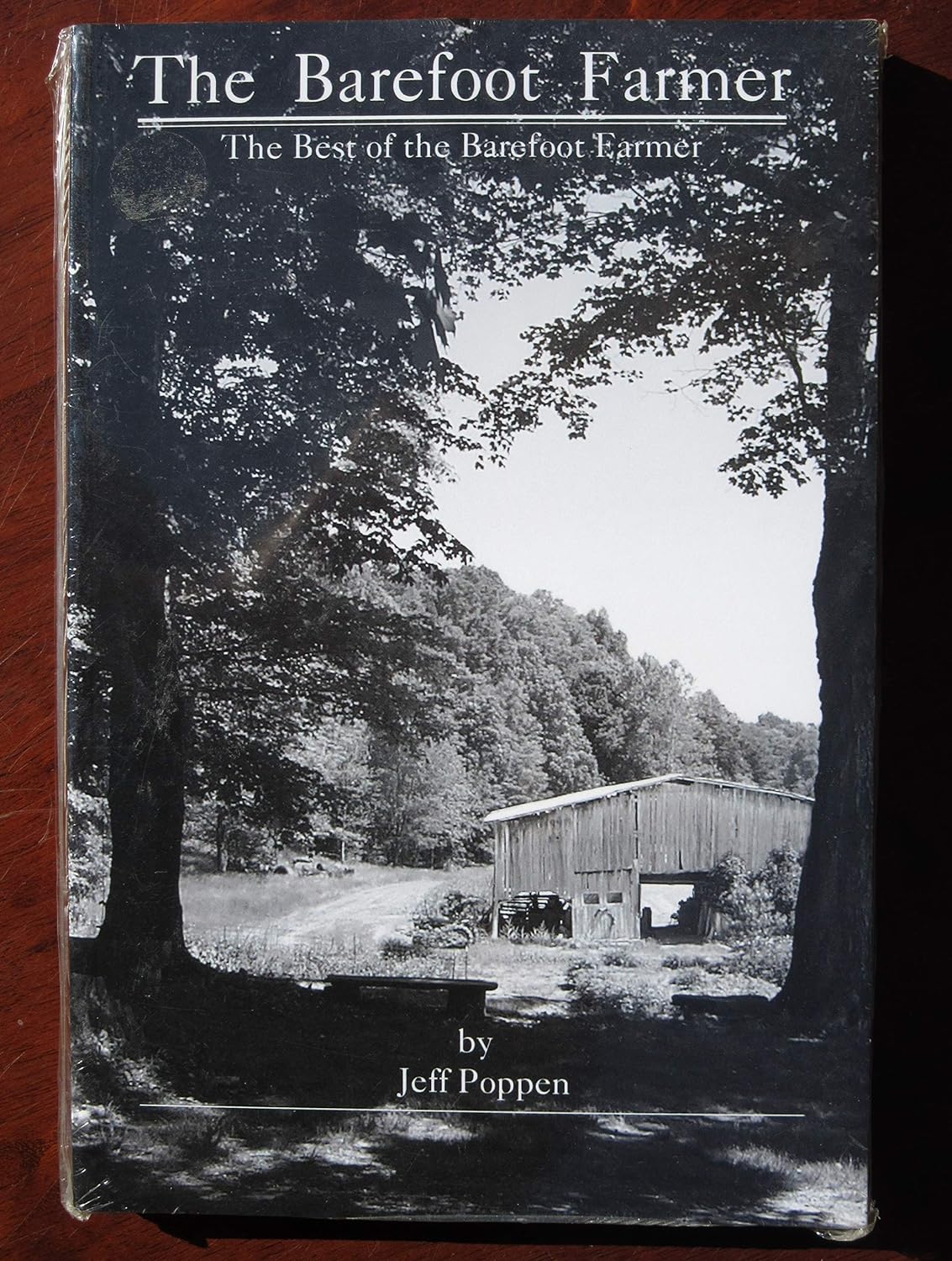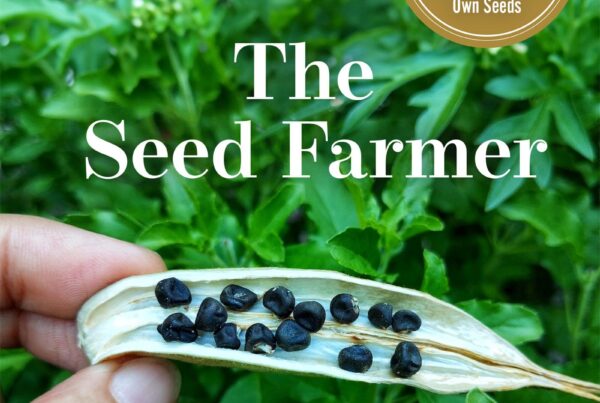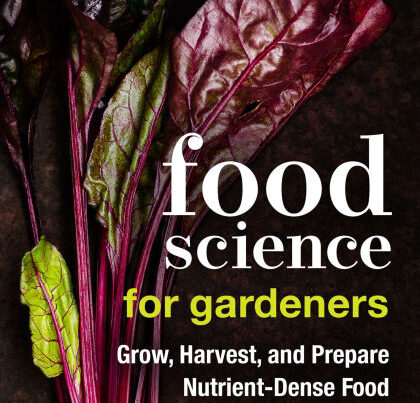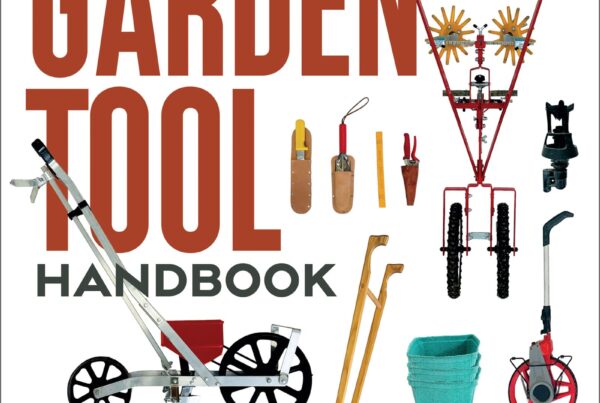 Jeff Poppen at Long Hungry Creek Farm, TN, is a lively and fascinating farmer and writer. Jeff’s style is folksy, lyrical, reverent, amusing, at times whimsical or iconoclastic, and always attentive to what works, what benefits the land, and how to farm better. No doubt you will heartily agree on some points, and heartily disagree on others! These two small books are compilations of pieces he wrote weekly for his local paper from 1993-2000 and 2000-2011, revised and updated. Jeff is a flexible Biodynamic farmer, who writes for all growers and farmers who care about good food and the long-term future. Jeff’s farming joy spreads wide, with gatherings at his farm, music, TV shows, community events and mentoring young farmers. In addition to these two books, Jeff has written a digest of Agriculture, the teachings of Rudolf Steiner, the founder of Biodynamics.
Jeff Poppen at Long Hungry Creek Farm, TN, is a lively and fascinating farmer and writer. Jeff’s style is folksy, lyrical, reverent, amusing, at times whimsical or iconoclastic, and always attentive to what works, what benefits the land, and how to farm better. No doubt you will heartily agree on some points, and heartily disagree on others! These two small books are compilations of pieces he wrote weekly for his local paper from 1993-2000 and 2000-2011, revised and updated. Jeff is a flexible Biodynamic farmer, who writes for all growers and farmers who care about good food and the long-term future. Jeff’s farming joy spreads wide, with gatherings at his farm, music, TV shows, community events and mentoring young farmers. In addition to these two books, Jeff has written a digest of Agriculture, the teachings of Rudolf Steiner, the founder of Biodynamics.
The articles have been re-arranged by themes, with part of each book on specific aspects of his farming, particular seasons, individual crops, farming past, present and future. The first book starts with the importance of organic matter, compost, and learning from what is happening under our noses and eyes. By watching what a bug does, we may better understand why it’s there and how it relates to the whole local environment. We may learn to make changes in what we do, rather than focusing on eliminating the cause of the holes in the cabbage leaves. Understanding our soil structure will give us appreciation of how the growing and dying of roots improves soil.
Here is an example of Jeff’s humor, realism and humility: “Although I make many tons of compost during the winter feeding of our cattle, it is just not enough. So I’m admitting to an overabundance of idealism and a lack of poop.†He cleans out other people’s barns.
Cover crops increase the canopy of leaves collecting solar energy, transforming it into more plants and then more animals. Mother Nature sends in weeds to cover bare ground. Thomas Jefferson apparently wrote that an acre of buckwheat is worth ten loads of dung. Jeff observed how a field of buckwheat rescued a sweet corn patch. In a dry spring the corn seed did not emerge, so Jeff over-sowed with buckwheat to put some roots in the ground. The buckwheat sprouted with the dew (no rain or irrigation). When the buckwheat reached flowering (still no rain), Jeff noticed the corn had grown, presumably benefitting from the buckwheat roots moving the dew deeper into the soil.
Jeff’s description of broadcasting cover crop seeds is quite poetic, and starts with “I quiet myself.†Many people who have broadcast seeds will recognize the attentive state and loose limbs that are needed to do the job well.
Jeff’s farm became a Community Supported Agriculture farm in 1997, with 32 members paying a monthly fee to receive a box of seasonal produce and opportunities for community events at the farm.
The first book divides crops by season, starting with potatoes in spring, which Jeff chits (pre-sprouts) as we do. By setting the potatoes in flats indoors for a few weeks, the certainty of plant emergence and therefore the yield can be increased, and if the conditions aren’t right on the hoped-for planting date, planting can be postponed, while the potatoes continue to grow. Jeff tried many varieties of potatoes and found that the ones that did best were Kennebecs and Red Pontiac from the local feed store. Funnily enough, we’ve also come down to planting those two, here in central Virginia!
They grow Ebenezer onion sets, knowing they will not store. In the fall, Jeff replants remaining non-storing onions packed in a trench. These provide early green onion tops next year. Onions from seed are started in a coldframe in late September. He plants the bareroot starts out in mid-March. Walla Walla do well for big onions to eat soon, but Copra do best for storage.
With asparagus, Jeff learned the same lesson I did: do not follow instructions to plant new crowns 12″ deep! They will do better 5″ deep. Really!
A week after planting big seeds (potatoes, squash, beans, corn), before seedlings emerge, Jeff runs over the rows with a spike-tooth harrow (large-scale) or rake (small-scale), dispatching tiny weeds without damaging the seeds below the surface. There are many practices like this that we could gainfully employ to reduce our weeding work. When hoeing, observe your plants, and any problems. Squash any pest bugs as you go. Fill gaps in the row from a seed packet in your pocket.
Jeff grows rye and Austrian winter peas for the cover crop preceding winter squash, then in mid-April mows strips down in each place he wants a row, and adds manure. When the squash vines start to run, Jeff mows down more of the cover crop, now flowering, making a no-till mulch right where it’s needed.
Jeff explains the American system of growing some crops on hills, which has always mystified me, an immigrant. He says the root areas dry out more, mimicking the desert conditions they came from. Another reason is helping to locate a large amount of fertility right where these large plants will need it initially. 6-8 seeds are planted in a circle in the center of the 2′ diameter hill, with hills many feet apart.
Jeff describes a sweet potato planting stick made by his neighbor. A stick with a notch in it and an attached wire is used for both pushing the slip down into the soil, and measuring the distance to the next plant. These newspaper articles still contain original comments such as that Jeff has left his surplus sweet potato slips at the feed store for anyone who wants to take some. Later he’ll offer home-grown kale seed, and invite people to leave their bags of leaves at the feed store for him to collect.
The fall garden needs prompt planting. August 4 leaves them 70 days to frost, and is their last chance to sow beans. Cabbages follow their early beans, using the remains of the moisture and compost left by the beans. To ensure the seeds get enough moisture to germinate, he presses them firmly into the soil. He likes to do this by walking heel-to-toe along the row. Yes, he does farm barefoot. And attends conferences barefoot. He wears shoes for tractor work.
Next is a section on putting food by. This includes moving storage crops into more ideal long-term locations, as well as solar drying, canning, jellies, jams, pickles and soups canned in jars. Seed saving follows, including chickpeas (garbanzos) which their local organic gardening club trialed.
Celery is a valuable plant for attracting beneficials if it flowers. In the summer the center of the celery plant dies; we always cut ours out, enabling the side shoots to grow into big plants themselves. I was interested to see that Jeff does as we used to do, moving some large plants into the greenhouse (hoophouse in our case) to supply stalks all winter. Several berry crops are mentioned and I was amused to read that when Jeff asked an orchardist how to keep birds out of his cherry trees, the orchardist replied “Plant mulberries!â€
Jeff has done a lot of work with apples, collecting and trying different kinds, and grafting. At the turn of the 20th century there were 6,000 apple varieties (in the US?). Before the turn of the 21st century, we were down to 2,000. Jeff writes about many of his favorites, Lodi, Yellow Transparent, Early Harvest, Little Strawberry, Golden Sweet, Pink Sweet, Grimes Golden (susceptible to cedar-apple rust), Mollie’s Delicious, Liberty (resistant to many diseases including fireblight), Winesaps, King David, Jonagold, Jonagrimes, Gala, Blushing Golden, Rusty Coat, Fuji, Yates, Arkansas Black – all good. Avoid Ben Davis.
Pruning is an important skill (“When do you prune fruit trees? When the pruning shears are sharpâ€). Jeff avoids winter pruning, apart from removing damaged wood and shaping the tree, and favors May-early June pruning for fruit bud formation. Winter pruning stimulates vegetative growth rather than the formation of fruit buds. When there is plenty of growth happening, fewer fruit buds grow for next year. Jeff has grafting tips too, including that masking tape works well for top grafting.
Volume II includes advice on pears, which are easier than apples to grow without pesticides, if you choose good varieties. Jeff favors Magness, Warren and Maxine, which are resistant to fireblight. Choose a site on a hill, to spill the frosts away, and late-blooming varieties to avoid losing fruit to late spring frosts.
The first book goes beyond the garden into the fields. Jeff is an advocate of integrating livestock into all vegetable production, to improve self-reliance and food quality. Jeff says the annual dropping of manure from one cow can fertilize 4 acres if carefully used, whereas the cow herself only needs two acres of pasture. Cows provide a valuable service, even if you don’t avail yourself of dairy products or meat. Hindus are vegetarians, but may keep cows. Jeff says that ancient wise people forbade the eating of meat, so that cattle, sheep and goats survived the years of famine, keeping the future of their agriculture safe. Rudolph Steiner said that farming is never sustainable without livestock. He proposed that with the proper number of animals, a healthy farm can produce all its own food, feeds and fertilizers.
Jeff gives a brief explanation of Biodynamics and the role of the field sprays, cow horns filled with manure or ground quartz paste, and buried. He makes it clear that fertilizing with horn manure and horn silica do not replace manuring in the usual way. It is vital to continue good farming practices. The six Biodynamic compost preparations, used in tiny amounts in compost and manure piles are thought to radiate living forces and make the compost or manure more effective. It is not necessary to believe this to try it and see what happens. Jeff is on record as saying that when he first learned about the horn manure, he thought it was a load of hogwash. He also noticed that the farms it was used on were wonderfully fertile. He has been using Biodynamic methods (mostly) ever since.
I believe that there are many ways of being a good farmer, and I respect all good farmers. The keys seem to be attentiveness, fantastic memory or good record-keeping, and modifying what you do based on what happened with what you last did.
Jeff writes about planting by the Stars/Zodiac Signs; the fire, earth, air and water elements; and fruit, root, flower and leaf plant parts that correspond in this system. He tries to work with the moon and the planets, but the weather is the determining factor in what they do each day. His approach is that nature is forgiving, and if you plant on the wrong sign, the seeds can sit in the soil until the right sign comes round again. It is probably unscientific to disregard anything, he says.
The second volume opens with the mission statement of their farm: “Our aim is to grow high quality food and help others do the same, and to educate ourselves on how this is most efficiently accomplished.†There are several sections with topics similar to those in volume I. Jeff believes in using a moldboard plow, slowly, in the fall, to open up new fields for gardens. He likes to let the winter weather convert the exposed soil to a friable state. He recognizes that plowing has gone “out of fashion†and that the soil life suffers and must be replenished. He knows when to stop cultivating soil to avoid destroying the structure. He recognizes when he needs to use a subsoiler or a chisel plow (rebreaker) to break up the hardpan that develops.
In volume II, Jeff often writes about his experiences farming without any irrigation, 2000-2011. Compost, mulch, good humus, can help a lot. Here’s a trick Jeff used in a dry summer to get the fall garden to sprout: right after bushhogging the old beans, summer squash and cucumber beds, he made new furrows and sowed seeds. He walked over the rows, pressing in the seeds. The moisture from the shredded plants and the shade of the old plants (now mulch) was enough to germinate the seeds. Before the use of chemical fertilizers, market gardeners added 50-75 tons of composted manure per acre each year, and had a quarter of the garden space in cover crops at any given time. How much compost to use has been much debated in recent years. Are you really seeing damage if you use more than some people recommend? Or are you seeing better growth, higher yields? Paying good attention is key.
Jeff says “I’ve two answers for most garden questions: Either “add more compost†or “I don’t know.â€
In another section, Jeff explodes some garden myths, teasing out the threads of truth they contain. Are heirloom seeds always better than hybrids? For some crops, open-pollinated varieties do well. OP, not necessarily heirloom. For other crops, hybrids do better: broccoli, sweet corn, tomatoes, peppers. Let’s appreciate the skill and hard work of plant breeders who have brought us varieties with better disease-resistance, increased productivity, better weather-resistance, and yes, sometimes better flavor. Let’s see what actually grows best in our particular gardens, for our particular needs.
To qualify for Organic certification, compost must reach 150F, but Jeff prefers not to let his compost get hotter than120F, to preserve more of the original microbes. He also prefers not to turn compost as the certificate requires, but to let it sit undisturbed for a year to encourage fungal growth. Organic certification is not always the measure of good practice. It allows use of some fertilizers that can leach in the soil and harm good microbes. It allows some toxic pest control products extracted from plants. (Maybe not as many nowadays as when written in 2009.) Jeff has moved away from Organic certification, as some other farmers have done, because he considers he can do better than Organic.
Crop rotations optimize the use of soil nutrients, because different crop families use them in different proportions, and return them to the soil in different proportions. Jeff’s approach is to alternate not only crop families, but also plants with varied edible parts: roots, leaves, fruits, to prevent the soil becoming sapped of particular nutrients.
When writing about warm weather crops, Jeff claims that tomatoes like to grow in the same spot every year. This I have strong doubts about. Maybe it works in places with few soilborne diseases and pests. Jeff says they have been lucky (up to 1999).
Some plants do better after particular others. Potatoes don’t do so well after carrots, beets or other crops requiring lots of tillage. Heavy nitrogen feeders such as corn, do well after nitrogen-fixing legumes. Big seeds can be sown in rougher soil than tiny seeds. Jeff rotates crops intuitively, considering the big picture. This is perhaps a method best used by experienced growers with knowledge of the big picture, and not so helpful for beginners, or team-run farms.
Similarly, prioritizing tasks for the day, is easier once you have more than a decade of experience under your belt! If it’s going to rain soon, do the tasks impossible after rain. If it ends up not raining, what will you regret not doing? Don’t just choose the job you most like doing. Keep your mission in mind.
Weeds are best controlled before visible! Prepare the bed, leave it a few days, rake shallowly and plant. A few days after planting, if it is dry enough, rake lightly again, right over the seeded bed. With potatoes, the hoeing between planting and emergence can be deeper, and is very worthwhile. With early-sown carrots, take advantage of the period before the carrots germinate to get rid of millions of fast-germinating weeds. Develop good hoeing posture, keeping your back straight, hinging at the hips, and switching sides back and forth. Don’t get very good at hoeing only to your best side! Jeff paces himself, dividing the length that needs hoeing by the time that seems reasonable. It’s more important to get to the end, doing an 80% perfect job, than to hoe only part of the row, leaving the rest to grow bigger weeds. He reckons on 10 feet per minute. The 80/20 Pareto Principle guides much of his work: “In my life, 20% of the weeds are ignored, 20% of the blueberries are left unpicked, 20% of the grass is unmown, and 20% of my life is a mess. But my cup is 80% full.â€
It’s worth pulling up pigweeds that miss the hoeing. Millions of pigweed-loving microbes die and become food for the crops. But if the pigweed continues to grow, pigweed-loving microbes multiply and more pigweed seeds germinate.
The later chapters of volume II are about livestock, pasture and hay, and biodynamics. Not being a biodynamic or livestock farmer myself, I paid less attention to these chapters.







